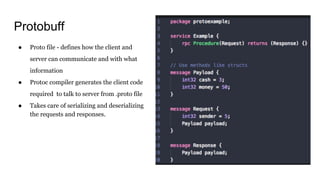gRPC services testing
- 2. What is gRPC ? Remote Procedure Calls Protocol developed by Google Client communicates with the server by calling functions defined on the API as if they were local. Increasingly popular on microservices architecture for internal service communications Where data from the service is not directly consumed by a web browser Faster, efficient protocol with lesser network overhead - built on top of Http2 (connection reuse,parallel requests) and protobuff
- 3. RPC - Working gRPC client talks to server via gRPC channel gRPC sends request(s) to the server and returns the serverâs protocol buffer response(s) to the client. gRPC uses protocol buffers (created by Google) as the data interchange format Unlike JSON, protocol buffers are a binary Interface Definition Language (IDL) which makes it much faster for computers to process. Calls can be synchronous or asynchronous Client and server in different languages
- 4. Protobuff â Proto file - defines how the client and server can communicate and with what information â Protoc compiler generates the client code required to talk to server from .proto file â Takes care of serializing and deserializing the requests and responses.
- 5. Accessing rpc services Using gRPC CLI - Polyglot Commands: List_services java -jar ~/Downloads/polyglot.jar --command=list_services --endpoint=localhost:50051 --proto_discovery_root="./proto" Call echo "{'name': 'World'}" | java -jar ~/Downloads/polyglot.jar --command=call --full_method=helloworld.Greeter/SayHello --endpoint=localhost:50051 --proto_discovery_root="./proto" --deadline_ms=3000
- 6. Accessing rpc service programmatically Test the API as a whole unit in itself - seeing it as a black box that accepts a request and returns a response






